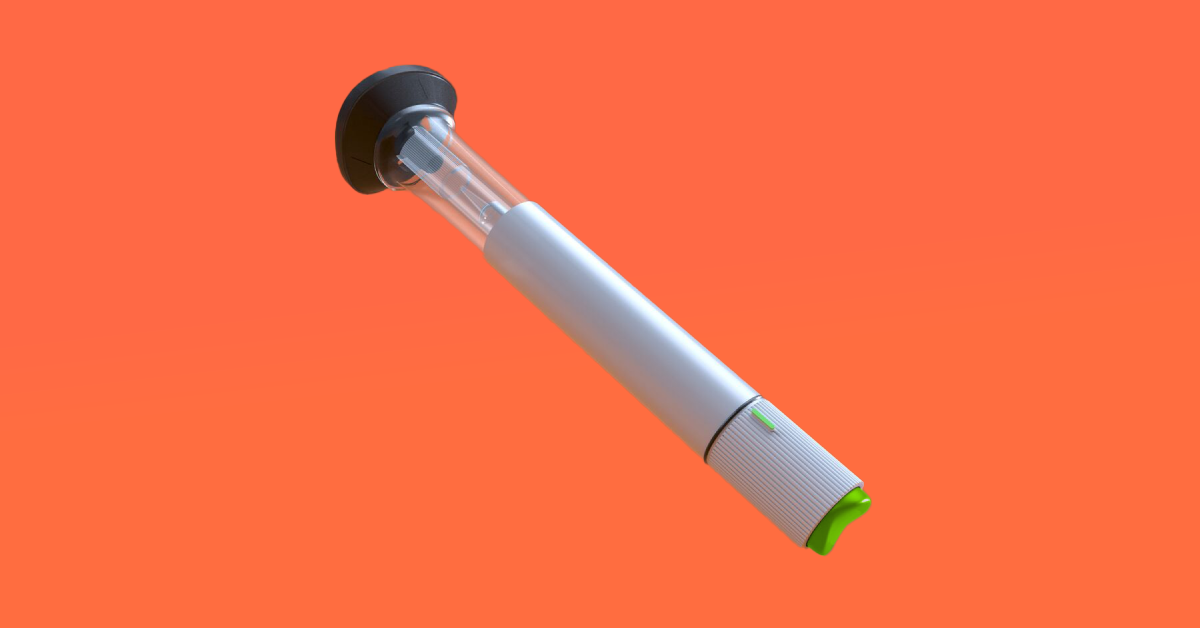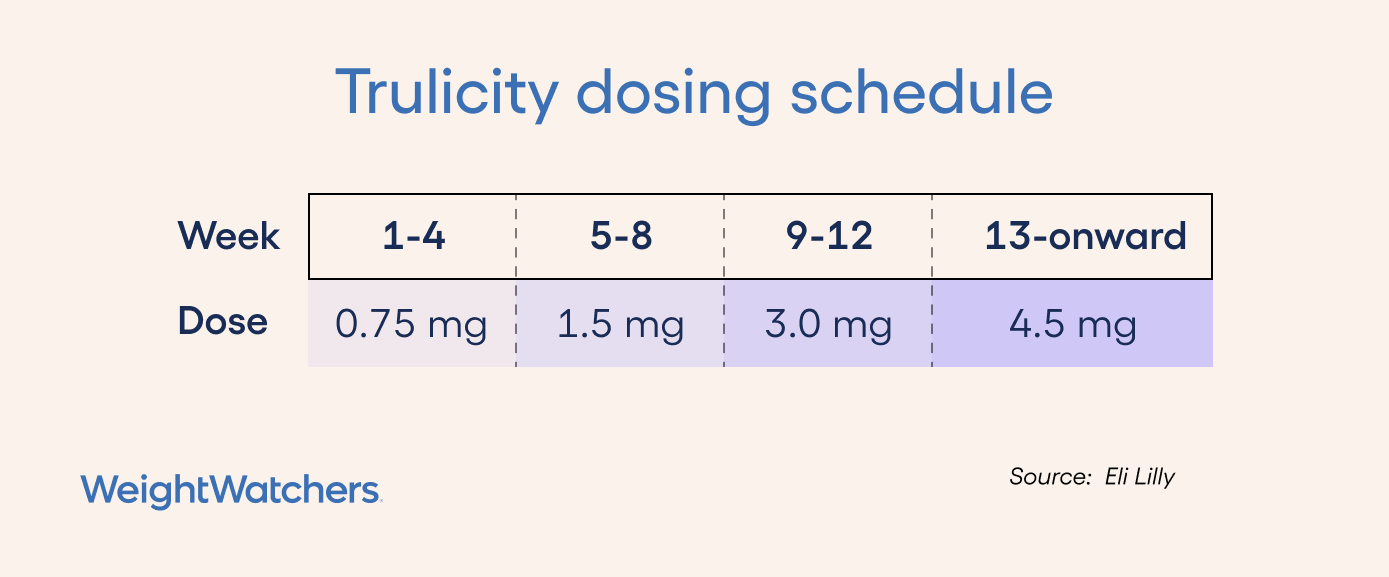Everything you need to know about Trulicity dosage


In this article:
1/ Typical Trulicity dosing schedule
2/ What strengths does Trulicity come in?
3/ How many doses are in a Trulicity pen?
4/ Forms of Trulicity (dulaglutide)
6/ What happens if you miss a dose of Trulicity?
7/ What to do if you overdose on Trulicity
8/ Can you change your Trulicity dose date?
For GLP-1s like the type 2 diabetes medication Trulicity, taking the right dose is key to managing your blood sugar well and losing weight. But there are four different Trulicity doses, and the optimal choice can vary from person to person. So how do you find the right dose for you? Your doctor can help, but here are some key points to keep in mind.
Typical Trulicity dosing schedule
Trulicity is the brand name for dulaglutide that’s FDA-approved for type 2 diabetes. It comes in four doses: 0.75 mg, 1.5 mg, 3.0 mg, and 4.5 mg. The medication is delivered through a weekly injection with a pre-filled pen.
Your prescribing healthcare provider will guide you on what dosage to take, but most people begin with the 0.75 dose to allow their body to get used to the medication, according to Dr. Alexandra Sowa, M.D., a New York City-based physician double-board certified in internal medicine and obesity medicine, and the author of The Ozempic Revolution. You'll take that dose for at least a month before increasing it.
Your timeframe for going up in Trulicity dosing will depend on your blood sugar control, how you're feeling, and whether you're experiencing notable side effects. "Much like other GLP-1s, how you respond to the medication will be the main driver for dosage increases," says Sowa. "Your doctor will look at how well it’s regulating your daily blood sugar and whether you're experiencing side effects that seem disruptive to everyday life."
Every medication comes with side effects, and Trulicity is no exception. According to its manufacturer Eli Lilly, the most common for Trulicity are nausea, diarrhea, vomiting, abdominal pain, decreased appetite, indigestion, and fatigue. (Find the full list of side effects on Trulicity’s site.) People often feel more intense side effects when first starting Trulicity or when going up in dosage, Sowa says, but those tend to resolve as you get used to the medication. Hence the reason for the slow pace of increasing dosage.
And while Trulicity doses go up to 4.5 mg, you may not need to ever take the maximum dose, says Sowa. If a certain dosage is controlling your blood sugar, you'll likely stay at that amount unless it becomes less effective. "Some people achieve blood sugar control at just 1.5 mg, so they remain on that dose," she says.
Potential Trulicity dosage chart
Here’s how someone starting on Trulicity might schedule their dose increases, assuming their provider wants them to reach the maximum dosage of 4.5 mg:

What strengths does Trulicity come in?
Trulicity pens come in four different strengths — 0.75 mg, 1.5 mg, 3.0 mg, and 4.5 mg. Each pen contains 0.5 mL of solution (in addition to the drug dulaglutide, the solution contains stabilizers, water, and other inactive ingredients).
How many doses are in a Trulicity pen?
Each Trulicity pen is designed to provide a single dose of medication, no matter which dosage you're using. You give yourself the injection once per week and then dispose of the pen safely.
Forms of Trulicity (dulaglutide)
Trulicity is available as a clear, colorless liquid in a pre-filled pen intended for use by one person.
Because Trulicity is a relatively new medication — it was approved by the FDA in 2014 — there are no generic forms available yet on the market. Its patent expires in 2027, which means there may be a generic version of dulaglutide after that point.
How to use Trulicity
Once your healthcare practitioner prescribes Trulicity for type 2 diabetes management, you’ll give yourself the injection once a week, at the same time on the same day. It doesn’t need to be timed with food, you can choose whenever is most convenient for you. Here’s what you’ll do:
1. Remove the pen from the refrigerator or wherever else you keep it, leaving the base cap on until you're ready to actually do the injection so it stays sterile. Many people find there's less of a sting if they let the medication come to room temperature before using, says Dr. Allison Rhodes, M.D., who has dual board certifications in internal medicine and obesity medicine at The Ohio State University Wexner Medical Center.
2. Before you inject yourself, choose a spot, clean it with an alcohol swab, and let it air dry first. You can choose a spot on your stomach, thigh, or back of your upper arm. Try to rotate the injection site every time, says Rhodes. Although reaction-site issues like redness or tenderness resolve within a day or two, injection in the same spot every time can cause those reactions to last longer, which can raise the risk of infection or issues on the skin where you're doing the injection, she says.
3. Give yourself the injection by removing the cap and placing the end of the pen against your clean skin. You’ll then click the injection button, hear a loud click, and keep it pressed against your skin until you hear a second click, telling you the needle has retracted.
4. After you’re done, dispose of the prefilled pen. A helpful item for this is a sharps container, a small bin that’s usually bright red or yellow, and has a biohazard symbol on it. You can get this kind of container at any drugstore or can use another sturdy container with a lid, such as an empty laundry detergent bottle.
What happens if you miss a dose of Trulicity?
If you accidentally miss a dose of Trulicity, talk with your healthcare provider about what to do. If it’s within three days of your missed dose, they will likely recommend that you just inject the dose when you remember and then maintain your usual schedule from there, says Sowa.
If it’s been more than three days, your provider may tell you to wait until the next time you are supposed to give yourself a dose. If you miss more than a week, you may be advised to adjust your dose downward or even go back to the starting dose so your body can readjust to the medication, Sowa says.
Can you change your Trulicity dose date?
You can adjust which day of the week you take Trulicity to better fit your schedule. To avoid disruptive side effects, move your injection by one day at a time.
The bottom line
Trulicity, a GLP-1 approved for type 2 diabetes, comes in multiple doses. This can make taking the medication feel confusing, but most people will follow a specific dosing schedule, starting at the lowest dosage of 0.75 mg and then increasing the dosage after a month. From there, you may stay at that dosage if it’s regulating your blood sugar well, or your doctor might suggest increasing the dosage again for better type 2 diabetes control.
Whatever Trulicity dosage you're taking, it's helpful to establish a consistent routine to avoid missing doses or accidentally doubling up on doses. If you're experiencing any disruptive side effects, or you have questions about Trulicity dosing, always reach out to your health provider.
FAQs
The typical starting dosage for Trulicity is 0.75 mg once per week for the first four weeks of taking the medication, which helps the body adjust to its effects, says Sowa. After four weeks, you would then start taking 1.5 mg. Starting at a higher dosage like 1.5 mg is possible, but is more likely to cause disruptive side effects compared to the starting dose.
According to its manufacturer, Eli Lilly, Trulicity does not need to be taken with meals, so you can choose any time of day to take it. They suggest taking Trulicity at the same time on your weekly injection day, since that makes it more difficult to forget a dose.
Trulicity may interact with insulin, sulfonylureas, corticosteroids, loop diuretics, beta blockers, and some antipsychotics. Talk with your health provider about all the medications you take — including over-the-counter drugs and supplements — to limit the risk of drug interactions.
Related Articles:
This content is for informational purposes only and does not constitute medical advice, diagnosis or treatment. It should not be regarded as a substitute for guidance from your healthcare provider.
